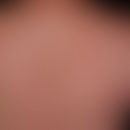DefinitionThis section has been translated automatically.
The COL14A1 gene (COL14A1 stands for: Collagen Type XIV Alpha 1 Chain) is a protein coding gene located on chromosome 8q24.12.
General informationThis section has been translated automatically.
The COL14A1 gene encodes the alpha chain of type XIV collagen, a member of the so-called FACIT collagen family(fibril-associated collagens with interrupted triple helices). Type XIV collagen interacts with the fibril surface and is involved in the regulation of fibrillogenesis. Associated signaling pathways include collagen chain trimerization and the integrin pathway.
The encoded collagen plays an adhesive role in the integration of collagen bundles. It is likely associated with the surface of interstitial collagen fibrils via COL1. The COL2 domain is then likely to serve as a rigid arm that protrudes from the fibril, allowing the large N-terminal globular domain to extend into the extracellular space where they can interact with other matrix molecules or cell surface receptors.
ClinicThis section has been translated automatically.
Diseases associated with COL14A1 include:
- Palmoplantar keratoderma, punctate type I (PPKP1A; OMIM: 148600), also called keratosis punctate palmoplantaris type Buschke-Fisher-Brauer, is a rare autosomal dominant inherited skin disorder characterized by multiple hyperkeratotic, centrally punctate papules that develop in early adolescence or later and are irregularly distributed on the palms and soles. There are reports of an association between die PPKP and the development of early- and late-onset malignancies, including squamous cell carcinoma.
LiteratureThis section has been translated automatically.
- Martinez-Mir A et al. (200ß3) Identification of a locus for type I punctate palmoplantar keratoderma on chromosome 15q22-q24. J Med Genet 40: 872-878.
- Pohler E et al (2012) Haploinsufficiency for AAGAB causes clinically heterogeneous forms of punctate palmoplantar keratoderma. Nature Genet 44: 1272-1276.
- Salamon T et al (1982) Peculiar findings in a family with keratodermia palmo-plantaris papulosa Buschke-Fischer-Brauer. Hum Genet 60: 314-319.



